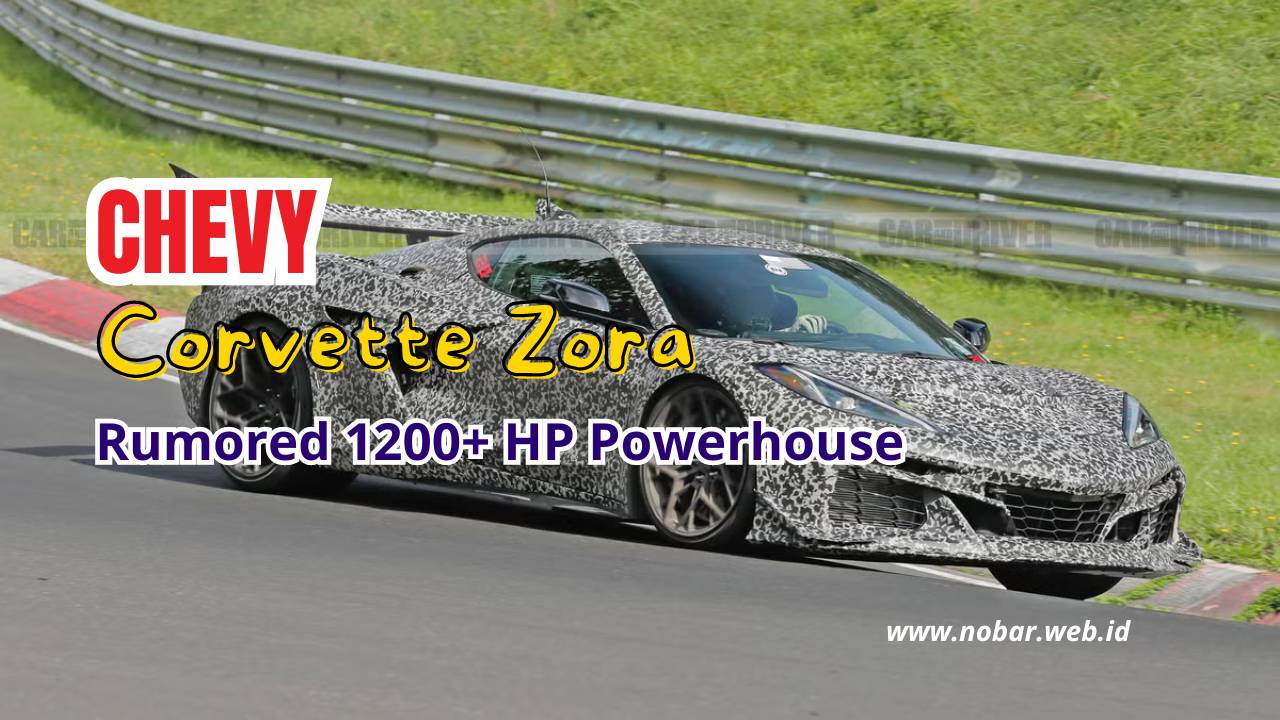The Chevy Corvette is a name synonymous with American muscle and performance. Over the decades, this iconic car has evolved from a sports car into a legitimate supercar contender, pushing boundaries with each new iteration. Now, the Corvette Zora, spotted testing with a prominent big wing, is gearing up to take the performance world by storm. With the possibility of over 1200 horsepower under its belt, the Corvette Zora is set to redefine what we expect from the Corvette lineup.
This article delves into the spy shots of the Zora, its expected powertrain, and how the big wing adds to its aerodynamics and handling. We’ll also explore how this model could change the landscape of performance cars with its rumored hybrid system and all-wheel drive (AWD) configuration.
What We Know from Spy Photos
Spy photographers recently caught a glimpse of the Corvette Zora undergoing tests on the infamous Nürburgring. While GM has kept most details under wraps, the spy shots reveal key features that hint at its monstrous potential.
The most eye-catching aspect is the massive rear wing. This prominent feature suggests that the Zora isn’t just about power, but also about precision handling at high speeds. With the Zora rumored to exceed 1200 horsepower, the large rear wing is likely crucial for providing the downforce necessary to keep the car planted on the road during intense performance driving.
Apart from the wing, the widebody design is another clear indicator of its performance focus. Similar to the Corvette ZR1, the Zora prototype features side-pod intakes, which are believed to help cool the rear brakes—a necessary addition given the incredible speed and power this car is expected to deliver.
The Big Wing and Its Aerodynamic Impact
Let’s talk about the big wing that has everyone buzzing. Wings are often seen on high-performance cars to aid in aerodynamic efficiency. In the case of the Corvette Zora, this oversized wing is not just for aesthetics. At extreme speeds, it provides much-needed downforce, improving stability and grip through corners.
When you’re dealing with a car that could potentially reach speeds close to 200 mph, keeping the rear tires planted is paramount. The big wing helps counter the lift generated at high speeds by creating downward pressure, ensuring that the tires remain firmly on the ground, giving the driver more control and confidence behind the wheel.
The wing also signals that the Zora is being designed with track performance in mind. The Nürburgring is known as one of the most challenging racetracks in the world, and testing there often indicates that a car is being fine-tuned for both speed and handling. The addition of the big wing suggests that Chevrolet engineers are pushing the Zora to its limits in terms of aerodynamics and downforce.
1200-Plus Horsepower: The Heart of the Zora
Now, let’s address the most exciting part of this upcoming beast—the engine. The Corvette Zora is expected to adopt the same twin-turbocharged 5.5-liter V8 that powers the Corvette ZR1, but with an electrifying twist. Reports suggest that the Zora will integrate the Corvette E-Ray’s hybrid system, which could add another 160 horsepower to the already monstrous V8.
If this rumor holds true, the combined output could exceed 1200 horsepower, placing the Zora in the hypercar category. This would make the Zora not only the most powerful Corvette ever but also a direct competitor to established European hypercars from brands like Ferrari, Lamborghini, and Bugatti.
The hybrid system, similar to what we’ve seen in the E-Ray, would power the front wheels, giving the Zora an all-wheel-drive (AWD) configuration. This setup allows for better traction, especially during acceleration, helping the car to achieve faster 0-60 mph times. It’s expected that the Zora could potentially break the 2-second barrier for the sprint from 0 to 60 mph, which would be a massive leap forward for the Corvette line.
Hybrid Technology: Power Meets Efficiency
Incorporating hybrid technology into the Corvette Zora is a bold move by Chevrolet. Traditionally, the Corvette has been all about raw, naturally aspirated power, but the automotive world is shifting. Hybrid technology is no longer just about fuel efficiency—it’s becoming a key element in maximizing performance.
The hybrid system in the Zora, borrowed from the Corvette E-Ray, uses a 1.1-kWh battery to power an electric motor on the front axle. While the battery may seem small compared to typical hybrid vehicles, it’s not designed for long-range electric driving. Instead, it delivers an instant power boost when needed, particularly during hard acceleration or cornering.
This hybrid setup doesn’t just add power, though—it enhances handling as well. By powering the front wheels, the electric motor helps the car pull through corners more effectively, reducing understeer and providing a more balanced driving experience. The addition of AWD will be a game-changer for Corvette enthusiasts, as it promises better grip and stability, especially in challenging driving conditions.
ZR1 vs. Zora: How Do They Compare?
The Chevy Corvette ZR1 is already an incredible machine, boasting over 1000 horsepower and a supercharged V8 engine. So how does the Zora stand out from its predecessor?
For starters, the Zora’s expected 1200-plus horsepower gives it a significant edge in raw power. While the ZR1 is focused on delivering rear-wheel drive excitement, the Zora’s AWD setup will make it more accessible for drivers who want a car that handles well in a variety of conditions.
Another key difference is the hybrid system. The ZR1’s power is purely combustion-based, while the Zora’s hybrid engine promises quicker acceleration and improved handling through the addition of the electric motor.
Lastly, the big wing on the Zora is noticeably larger than anything seen on the ZR1, suggesting a car that’s more focused on track performance and aerodynamics. The Zora could be the Corvette that finally matches or exceeds some of the best hypercars in terms of lap times and overall driving experience.
How the Zora Fits into the Supercar and Hypercar World
The supercar and hypercar markets are incredibly competitive, with brands like Ferrari, McLaren, and Lamborghini leading the charge. But the Corvette Zora could be a disruptive force. With its combination of American muscle, hybrid technology, and AWD, it’s poised to challenge the European elite.
The Zora’s expected price tag will likely undercut many hypercars on the market, offering similar levels of performance for a fraction of the cost. Corvette has always been known for delivering incredible value for the performance it offers, and the Zora is likely to continue that tradition.
In terms of performance, the 1200-plus horsepower figure puts the Zora in the company of cars like the Bugatti Chiron, Koenigsegg Jesko, and Ferrari SF90. If the Zora delivers on the rumored 0-60 mph times, it could very well become the most accessible hypercar in terms of both price and usability.
Chevrolet’s Vision for the Future: The Zora’s Role
The Corvette Zora represents more than just another high-performance model in Chevrolet’s lineup. It signals the future of Chevy’s performance division, where hybrid technology and all-wheel drive become standard features in the pursuit of better performance.
Chevrolet has always been known for pushing the envelope with the Corvette, and the Zora continues that legacy. With this model, Chevy is positioning itself as a serious contender in the global hypercar market, proving that American manufacturers can compete with the best of Europe in terms of both performance and innovation.
A New Era for the Chevy Corvette
The Chevy Corvette Zora, spied testing with its striking big wing, promises to be a game-changer in the world of high-performance cars. With its hybrid powertrain, AWD setup, and an expected 1200-plus horsepower, the Zora is poised to push the boundaries of what a Corvette can be.
As we await the official debut of the Zora, it’s clear that Chevrolet is gearing up to make a bold statement with this car. The Zora will not only be a tribute to Corvette’s storied past but a glimpse into its future—one where technology and raw power converge to create a hypercar that rivals the best in the world.



